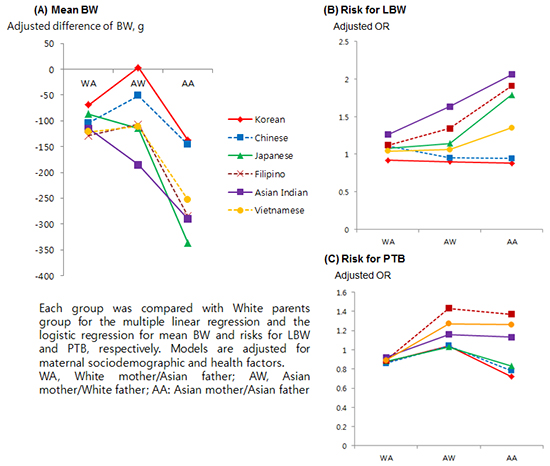2. Singh GK, Yu SM. Pregnancy outcomes among Asian Americans. Asian Am Pac Isl J Health. 1993; 1:63–78.
3. Singh GK, Yu SM. Birthweight differentials among Asian Americans. Am J Public Health. 1994; 84:1444–1449.
4. Le LT, Kiely JL, Schoendorf KC. Birthweight outcomes among Asian American and Pacific Islander subgroups in the United States. Int J Epidemiol. 1996; 25:973–979.
5. Fuentes-Afflick E, Hessol NA. Impact of Asian ethnicity and national origin on infant birth weight. Am J Epidemiol. 1997; 145:148–155.
6. Madan A, Holland S, Humbert JE, Benitz WE. Racial differences in birth weight of term infants in a northern California population. J Perinatol. 2002; 22:230–235.
7. Qin C, Gould JB. The Asian birth outcome gap. Paediatr Perinat Epidemiol. 2006; 20:279–289.
8. Rao AK, Cheng YW, Caughey AB. Perinatal complications among different Asian-American subgroups. Am J Obstet Gynecol. 2006; 194:e39–41.
9. Rao AK, Daniels K, El-Sayed YY, Moshesh MK, Caughey AB. Perinatal outcomes among Asian American and Pacific Islander women. Am J Obstet Gynecol. 2006; 195:834–838.
10. Wong LF, Caughey AB, Nakagawa S, Kaimal AJ, Tran SH, Cheng YW. Perinatal outcomes among different Asian-American subgroups. Am J Obstet Gynecol. 2008; 199:382.e1–382.e6.
11. Nystrom MJ, Caughey AB, Lyell DJ, Druzin ML, El-Sayed YY. Perinatal outcomes among Asian-white interracial couples. Am J Obstet Gynecol. 2008; 199:385.e1–385.e5.
12. Schempf AH, Mendola P, Hamilton BE, Hayes DK, Makuc DM. Perinatal outcomes for Asian, Native Hawaiian, and other Pacific Islander mothers of single and multiple race/ethnicity: California and Hawaii, 2003–2005. Am J Public Health. 2010; 100:877–887.
13. Institute of Medicine Committee to Study the Prevention of Low Birthweight (US). Preventing Low Birthweight. Washington, D.C.: National Academy Press;1985.
15. Acevedo-Garcia D, Soobader MJ, Berkman LF. The differential effect of foreign-born status on low birth weight by race/ethnicity and education. Pediatrics. 2005; 115:e20–30.
16. Morrow HW, Chávez GF, Giannoni PP, Shah RS. Infant mortality and related risk factors among Asian Americans. Am J Public Health. 1994; 84:1497–1500.
17. Gould JB, Madan A, Qin C, Chavez G. Perinatal outcomes in two dissimilar immigrant populations in the United States: a dual epidemiologic paradox. Pediatrics. 2003; 111:e676–82.
18. Baker LC, Afendulis CC, Chandra A, McConville S, Phibbs CS, Fuentes-Afflick E. Differences in neonatal mortality among whites and Asian American subgroups: evidence from California. Arch Pediatr Adolesc Med. 2007; 161:69–76.
20. Lim JW, Lee JJ, Park CG, Sriram S, Lee KS. Birth outcomes of Koreans by birthplace of infants and their mothers, the United States versus Korea, 1995-2004. J Korean Med Sci. 2010; 25:1343–1351.









 PDF
PDF ePub
ePub Citation
Citation Print
Print




 XML Download
XML Download